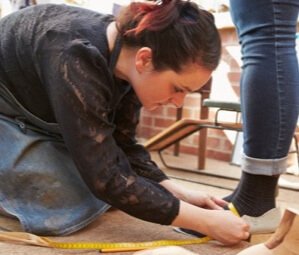Shoes for Lymphoedema

It is normal to have a small amount of fluid in your body tissues. The fluid leaves the blood system in order to provide fluid and nourishment for the tissues. The lymphatic system, which is a series of drainage tubes, does a very good job in most cases of collecting the fluid. When the fluid is not collected properly but builds up in the body instead, it is called lymphoedema.
Lymphoedema can affect any part of the body, but it is most commonly found in the extremities (arms and legs). It is a chronic condition for which there is no cure; however, there are steps you can take to control the symptoms and keep the swelling down.
How Common is this Condition?
Over 200,000 people in the United Kingdom may have lymphoedema, according to the results of a recent study.
Causes of Lymphoedema
When the lymphatic system develops abnormally, becomes damaged and/or there is an increase in fluid in the body’s tissues, it can cause lymphoedema.
Two main types of this condition exist.
Primary lymphoedema
Primary lymphoedema is due to a genetic abnormality that affects the lymphatic system. It can affect people of any age but symptoms usually appear in early adulthood.
Secondary lymphoedema
Secondary lymphoedema occurs as the result of some type of damage to the lymphatic system or a problem with drainage of fluid to the lymphatic system. It appears in conjunction with (or secondary to) an injury, infection or inflammation of a limb. Patients undergoing cancer treatment may develop this condition.
How to Keep Swelling Down
People living with this condition usually notice that the swelling is worse at the end of the day and that it tends to settle down through the night. Wearing compression bandages or stockings during the day will help to control swelling.
Elevating the legs will also help, since this will encourage fluid to drain out of the feet and ankle region. Some people find that raising the end of the bed by six inches so that their feet are higher than their head at night also helps to keep the swelling down.
How to Find Shoes for Lymphoedema
When you are living with chronic swollen feet, how do you find comfortable shoes to wear? It is possible to find something that is comfortable and looks fashionable as well?
You don’t have to give up on the idea of having attractive looking footwear simply because you live with swelling in your legs and feet. It is important to look for shoes that don’t exacerbate your condition.
Here’s what to look for when you are shopping for shoes:
- Have your feet measured before you buy a new pair of shoes
If you are experiencing swelling, your “usual” or “normal” size may no longer be the right size for you. Online shoppers can find the right size with this simple foot measuring guide.
- Look for shoes with a wide toe box
The toe box is the front of the shoe, where your toes fit when you are wearing the footwear. If the toe box is too narrow, there will not be enough room to accommodate your toes comfortably, even without taking into account any swelling in your feet. The shoes will be very uncomfortable to wear, even if you are able to put them onto your feet.
-
Look for wide-fit shoes for comfort
Since your feet will swell in width when you have lymphoedema, a standard width shoe may not feel very comfortable on your foot. Wide fit shoes come in more than one width to accommodate people with different foot sizes and different levels of swelling. If you already have a wide foot and then have swelling due to fluid retention, you can still find shoes that will fit well and be comfortable.
-
Consider shoes that are adjustable
Since the level of swelling that you experience can vary, you’ll want to find shoes that will stay comfortable on days when you have more or less swelling than others. Look for shoes in styles that lace up. You can find a variety of options, from dress shoes for men and women to casual shoes and trainers in the wide fit you need.
Another choice available to you is to look for shoes that have one or more straps with a Velcro closure. This style is very easy to get on and off, and you can adjust the fit to keep the shoe snug, depending on the level of swelling you happen to have on a daily basis.
Going barefoot is not recommended for people living with lymphoedema (since you don’t want to run the risk of damaging your tender tootsies) which means you need to invest in quality footwear that fits well and is built to last. Wide Fit Shoes is the place to get your trotters outfitted in both comfort and style, while protecting your one and only pair of feet.
5 Surprising Facts about Lymphedema
-
Women Are Commonly Diagnosed with Lymphedema
Both men and women that have endured a recent surgery to remove lymph nodes and/or have undergone radiation therapy are at risk for developing Lymphedema. However, women are more commonly diagnosed with the condition, especially those recovering from recent breast cancer surgery. A potential 49% of patients that have undergone breast cancer are at risk to develop lymphedema within the first two years after surgery.
- The Chances of Secondary Lymphedema Can Be Reduced
While primary Lymphedema is unable to be prevented, there are ways to reduce your risk of developing secondary Lymphedema. There are several steps one can take to help reduce the risk and symptoms of Lymphedema such as:
- Avoid heavy lifting
- Drink plenty of fluid
- Avoid environmental irritant in the affect area such as sunburns and insect bites
- Practice good hygiene
- Avoid tight clothing and jewellery on the affected areas
-
Lymphedema Can't Be Cured
Although Lymphedema is unable to be cured, there are treatments available that help maintain the condition and reduce the severity of its symptoms. Seek out advice from a medical professional on different treatment options.
-
Bacterial Infections are Common with Lymphedema
The immune system has been weakened in the affected areas by Lymphedema allowing bacterial infections to develop more often. These infections are most commonly developed in the skin or in the tissues beneath the skin. Any bacterial infections in the Lymphedema must be treated seriously and treated by a medical professional immediately. Without proper treatment to the infected area, you are at risk of it spreading to other body parts.
-
Long-Term Lymphedema Can Result in Cancer
Lymphangiosarcoma is a rare cancer of the lymphatic vessel that can develop with long-term lymphedema. Those that have been dealing with lymphedema for ten years or longer are at risk for developing this type of cancer. Lymphangiosarcoma often appears as a reddish lump on the skin and can spread rapidly. The most common form of treatment for Lymphangiosarcoma is amputation of the affected limb.
Sources
- www.nhs.uk/Conditions/Lymphoedema/Pages/Introduction.aspx
- www.circulationfoundation.org.uk/help-advice/other-vascular-information/lymphoedema/
- http://www.emedicinehealth.com/lymphedema-health/article_em.htm
- http://lymphcare.com/facts_about_lymphedema
- http://international.l-dex.com/facts-about-lymphedema/
- http://lymphaticnetwork.org/news-events/lymphedema-facts-and-risk







